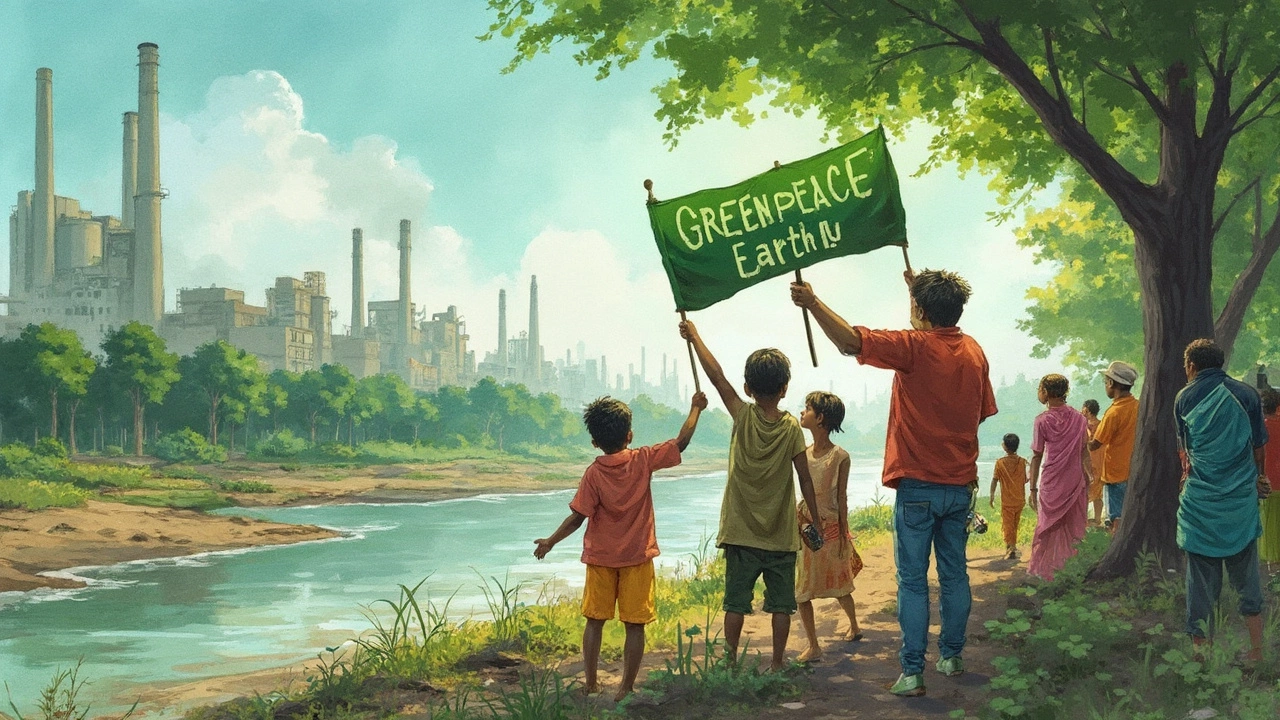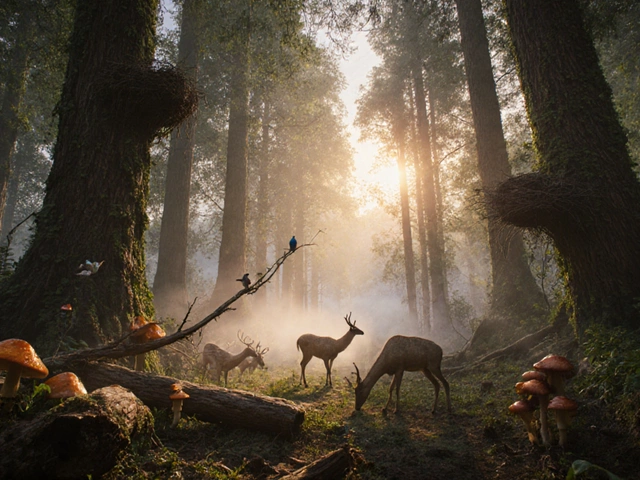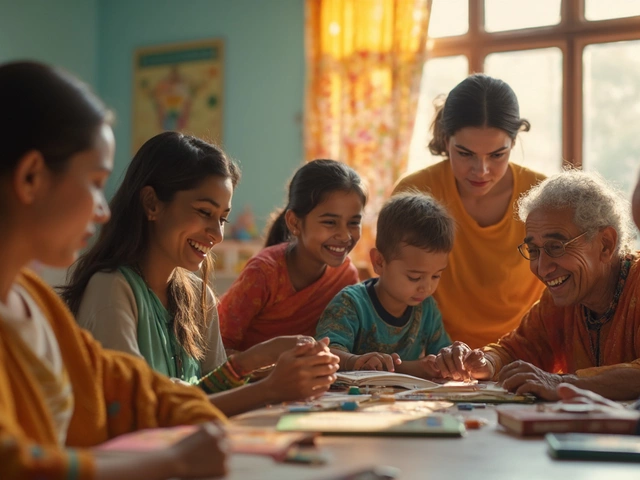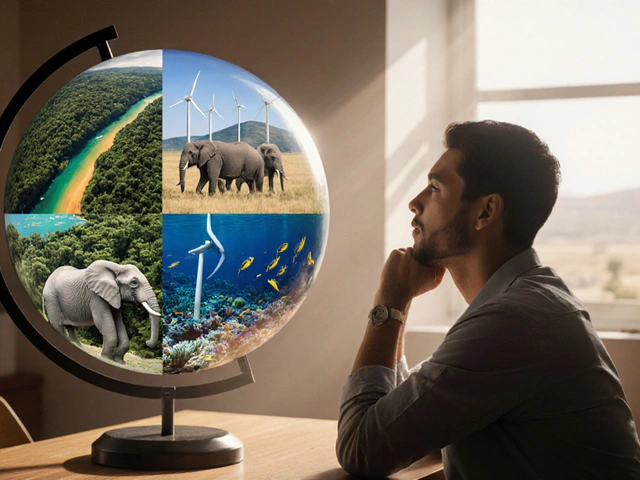Imagine a world where rivers run neon green, words spray-painted on melting icebergs make headlines, and inflatable boats zoom right into the paths of whaling ships. Sounds a bit wild, doesn't it? But this kind of bold action has put one environmental charity front and center around the globe for decades. If you had to name the most famous environmental organization on the planet, chances are one name pops into your head instantly: Greenpeace. Ask anyone from a high school student to a grandparent, and they’ll probably recall those iconic images of activists chaining themselves to oil rigs or dangling off bridge spans with banners. But why has Greenpeace become so well-known among hundreds—maybe thousands—of environmental groups?
It’s honestly no wonder. With a history that reads like part spy novel, part eco-activist adventure, and loads of mainstream media attention, Greenpeace keeps finding ways to command headlines. My daughter Seraphina once asked me, “Mom, why do people dress as polar bears to protect the ice?”—and I had to tell her that some folks will go to any lengths, literally, to get the world to pay attention. Having that splash of wild, a bit of risk-taking, and an eye for drama, Greenpeace stands apart in the crowded world of Earth-saving groups. So, what really makes them the world’s most famous environmental charity, and how do they keep inspiring people year after year?
The Birth and Rise of Greenpeace
Greenpeace didn’t start out as an international powerhouse. It all kicked off in 1971 with a handful of passionate Canadians on the damp western coast, worried about nuclear bomb testing in Alaska. They jammed themselves onto a rickety old fishing boat, aptly named the Phyllis Cormack, and set sail from Vancouver. Their aim? To stop a U.S. nuclear test at Amchitka Island by physically putting themselves in the blast zone—and making sure the media couldn't ignore them. Sure, their journey didn’t literally stop the bomb, but their daring made headlines and grabbed the public’s imagination, and that was the point.
From that moment, Greenpeace became known for big, theatrical stunts—actions that got them noticed in ways quiet lobbying or polite petitions simply couldn’t match. They’ve since grown into a truly global movement, with offices in over 55 countries and more than three million supporters. Their campaigns have targeted everything from commercial whaling and toxic waste dumping to climate change and rainforest destruction. The group’s focus is direct action—think activists climbing smokestacks, surfing the bow waves of oil tankers, or chaining themselves to old-growth trees. Every action comes with a bigger goal: getting media attention so regular people, politicians, and corporations are forced to listen.
One thing that set Greenpeace apart from the start was its absolute refusal to accept money from governments, political parties, or corporations. This rule keeps them fiercely independent and, honestly, it’s one of their calling cards when you compare them to other eco-charities. That policy also means they rely entirely on ordinary folks chipping in—something that boosts trust but adds rolling management headaches every year. My son Lennon, who’s fascinated by superhero stories, always says Greenpeace activists are like real-life heroes for the planet, and there’s truth to that.
Here’s a little timeline table so you can see just how Greenpeace evolved:
| Year | Milestone |
|---|---|
| 1971 | Greenpeace launches first campaign to stop nuclear testing at Amchitka, Alaska |
| 1975 | Bold campaign against Soviet whalers draws global attention |
| 1985 | Rainbow Warrior flagship bombed in New Zealand (by French secret service!) |
| 1995 | Occupation of Brent Spar oil platform; leads to big oil reforms |
| 2009 | International campaign for Arctic protection begins |
| 2020 | Greenpeace campaigns push for major plastic waste reforms |
Sure, other groups had similar missions and even similar tactics, but Greenpeace was almost always out in front, upping the drama and bringing regular people—like my kids, like you—into the action. That’s a huge part of why their name has stuck so firmly in the public mind: not just because of their size, but because they never seem scared to ruffle feathers, even if it costs them friends in high places.
What Makes Greenpeace Stand Out?
So many environmental organizations have important stories, scientist-packed offices, and slick letterhead, but what is it about Greenpeace that keeps them famous year after year? A big part is their bold media tactics—no question. Their campaigns always aim for big visuals. It's the stuff that pops up in your newsfeed, the images kids put on science fair posters, or the shots you see during climate protests worldwide.
But media buzz is only one side of their coin. Greenpeace puts strong values front and center. That independent status—they never take government or corporate cash—is not just a talking point; it’s a serious operational rule. If you’re ever in doubt about whether to trust an NGO, this kind of independence is a good sign that a group walks its talk. Greenpeace fundraises directly from private supporters, which is no easy feat when running daring actions on several continents. Their annual reports (which even my daughter flips through—okay, she checks the pictures more than the numbers) show exactly where donations go: from ship upkeep to training activists, to undercover investigations into illegal logging.
Another thing? Their commitment to nonviolence. You’ll find dramatic actions, but you won’t find them brawling or destroying property. Even when they’re intercepting whaling vessels or hanging banners in off-limits places, Greenpeace insists on peaceful protest. That’s why their activists train rigorously, and you’ll see everyone wearing safety gear—not just for looks. It might sound like a little detail, but sticking to non-violent action helps keep them in the moral high ground, even when they annoy governments or corporations.
Some people love them, some roll their eyes, and plenty criticize their tactics. That’s normal for a group this visible. But another stand-out element: science. While the headlines often talk about attention-grabbing actions, behind each campaign is a bunch of research, scientist partnerships, and actual data collection. Greenpeace has funded (and sometimes led) studies on everything from microplastics in oceans to illegal rainforest logging. Their ships (like the ever-iconic Rainbow Warrior or Arctic Sunrise) double as floating science labs.
Want to make your own mark? Greenpeace makes it easy for supporters to get involved right from home. You can sign petitions, join protests, write letters, or even volunteer for research projects. You don’t need to chain yourself to an oil rig to help. Isn’t that refreshing?
Here are a few ways Greenpeace stands out from the crowd:
- They make problems—and solutions—dramatic and easy to understand for everyone.
- Their actions are global: from ice floes to rainforests, from Tokyo to Timbuktu.
- They mix art and activism (painted banners, choreographed stunts, creative costumes—think “zombie protests” outside coal plants).
- Back everything up with hard evidence—never just slogans.
- Rely directly on public support, not special interests or backroom deals.
Even their critics often admit: if a big company or government fears someone shining a global spotlight, it’s Greenpeace.
Iconic Campaigns and Controversies
No one is famous this long without ruffling feathers, and Greenpeace has had more than its share of showdowns and headlines—for good or ill. Some actions have saved entire whale species or forced big corporations to change policies; others sparked lawsuits, angered officials, or triggered heated debates over tactics. Let’s get into some examples.
The anti-whaling campaigns of the 1970s and 80s are the stuff of legend. Activists maneuvered tiny inflatable boats between harpoons and whales, risking their lives to get the perfect shot—photos broadcast worldwide. These campaigns led to the International Whaling Commission’s 1986 ban on commercial whaling, a global victory by any measure.
Fast forward to 1985—Greenpeace’s ship Rainbow Warrior was bombed in New Zealand by agents from France. The ship was about to lead a protest against French nuclear testing in the Pacific. The attack shocked the world, especially after a photographer onboard died. Instead of crushing Greenpeace, the bombing only grew their legend—and public support exploded almost overnight. It’s not every day a government admits to blowing up a charity’s boat, after all.
There have been stumbles too. In 2000, Greenpeace activists damaged ancient Nazca lines in Peru during a climate protest. Public outcry was swift; Greenpeace apologized and pledged better planning. Even eco-heroes make mistakes—but high visibility means those flubs can go viral lightning-fast.
Their anti-deforestation work has led to confrontations with logging companies, security guards, and even entire governments. In Brazil, for instance, their campaigns against Amazon destruction triggered both death threats and major logging reforms. And don’t forget their battles with oil giants over Arctic drilling—a decade-long saga involving court fights, ship impoundments, and daring blockades. Greenpeace grabs headlines because they don’t shy away from risks or controversy.
Here’s a peek at the scale of their achievements, in hard numbers:
| Campaign | Result/Impact |
|---|---|
| Anti-whaling | Led to 1986 worldwide ban on commercial whaling |
| Brent Spar | Forced Royal Dutch Shell to dismantle North Sea oil rig safely |
| Soy and palm oil campaigns | Pushed major brands to drop suppliers linked to deforestation |
| Plastic waste | Major companies pledged to reduce single-use plastics |
| Arctic protection | Millions signed; drilling moratoriums extended in key areas |
It’s not just feel-good moments. Despite occasional backlash, Greenpeace’s track record keeps them in the news and keeps their message sharp—even when it means admitting mistakes or weathering controversy.
Getting Involved: Tips for Supporting Greenpeace and Similar Causes
If you’ve ever thought, “I want to help, but I’m not going to chase a whaling ship,” you’re in good company. Most of us, myself included, want to make a difference but also have jobs, families (Lennon and Seraphina winding LEGO up in the living room as I write), and a full list of to-dos. Raising eco-warriors doesn’t require a superhero cape—just real commitment, however small.
Supporting well-known charities like Greenpeace doesn’t just mean sending a check (though believe me, those donations help power the ships and pay for bail!). There’s so much more you can do, and every little bit counts. Here’s what works, both from experience and talking with other parents and activists who’ve actually gotten kids, classrooms, and neighborhood groups fired up:
- Join campaigns online. Signing electronic petitions might feel “small,” but when millions join in, corporations and lawmakers start paying attention. Greenpeace’s digital actions have led to massive real-world changes—think plastic bag bans, ocean preserves, and corporate green commitments.
- Spread the message. Social media isn’t just for cat videos, right? Share the actions and wins from reputable groups; your post could spark another person to get involved.
- Volunteer locally. Greenpeace sometimes runs local events and beach clean-ups. These are family-friendly, and bring the stories to life—plus, picking up trash can be an adventure for your kids, believe it or not.
- Think before you buy. Greenpeace ranks brands on their environmental commitments—especially things like paper, seafood, electronics, and clothing. Use their consumer guides to make greener choices at home.
- Teach resilience, not perfection. If your kids mess up the recycling or forget a reusable bag, it’s okay. The real power comes from trying, learning, and inspiring each other—not from getting every eco-action perfect every time.
- Stay informed—question everything. Greenpeace and similar groups often publish detailed investigations; use these to fuel dinner table debates or school projects. Fact-check stories together; not every dramatic campaign turns out simple, and it’s good to understand why.
And if you want to do more than click or sort recyclables, Greenpeace loves getting volunteers into research, legal campaigns, media outreach, or even running “eco clubs” in schools. The trick is matching what you’re good at with what a group actually needs—whether that’s drawing a mural, writing an op-ed, or fixing old laptops for activists on the ground.
You’re not limited to Greenpeace, either. While they may be the loudest household name out there, loads of amazing groups—like Friends of the Earth, World Wildlife Fund (WWF), and local river-keepers—get big results too. What matters most is finding something that inspires you.
After all, what keeps any charity relevant, year after year, is the same thing that drew a few dreamers onto a fishing boat in 1971: regular people raising their voices, taking creative action, and refusing to just watch from the sidelines. Sometimes, the most famous environmental charity in the world is just a spark that lights your own passion to care.






